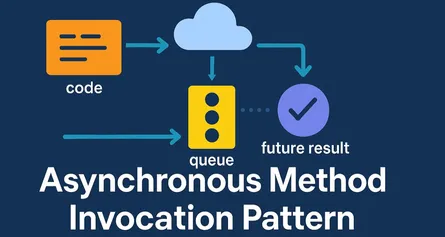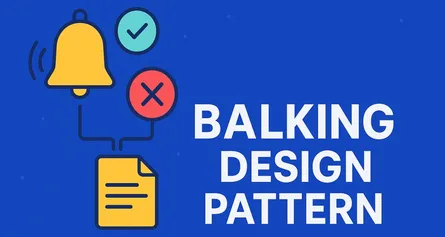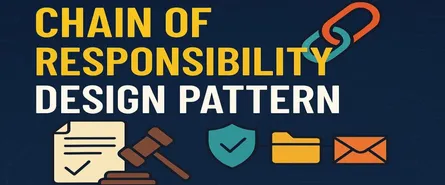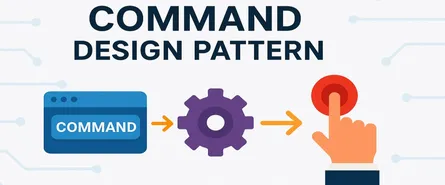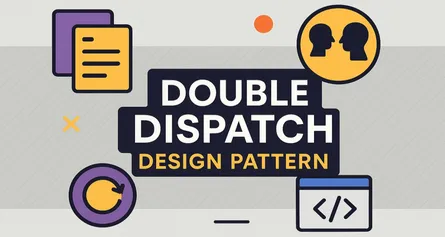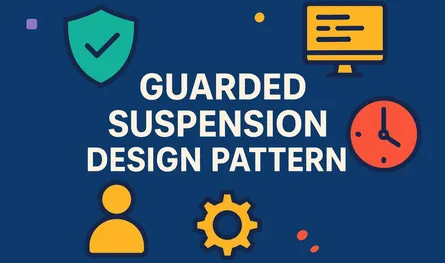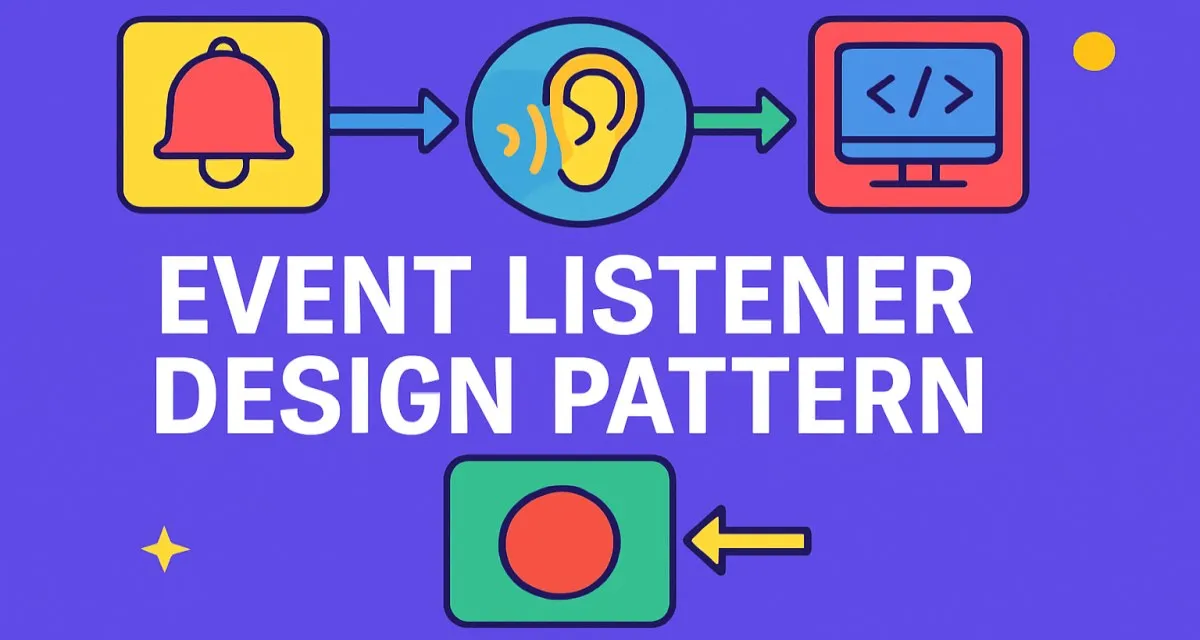
The Event Listener Design Pattern: A Comprehensive Guide for Software Architects
Introduction to the Pattern
Definition and Core Concept
The Event Listener Design Pattern, commonly known as the Observer Pattern, is a behavioral design pattern that establishes a one-to-many dependency between objects. In this setup, when one object (the subject) changes its state, all its dependents (observers) are notified and updated automatically. This pattern promotes loose coupling between the subject and its observers, allowing for a dynamic and flexible system where components can interact without tight interdependencies.
Historical Context and Origin
The Observer Pattern was popularized by the “Gang of Four” in their seminal book, Design Patterns: Elements of Reusable Object-Oriented Software. It addresses the need for a robust mechanism to maintain consistency between related objects without making them tightly coupled. Over time, this pattern has become fundamental in various programming paradigms, especially in event-driven architectures and user interface frameworks.
Position within Behavioral Design Patterns
Within the realm of behavioral design patterns, the Observer Pattern stands out for its ability to define a subscription mechanism to notify multiple objects about any events that happen to the object they’re observing. It facilitates communication between objects in a system, ensuring that changes in one part of the system are propagated to other parts that depend on it.
Core Principles
At its heart, the Observer Pattern is built upon the following principles:
- Encapsulation of the Subject’s State: The subject maintains its state and provides mechanisms for observers to register and deregister themselves.
- Notification Mechanism: When the subject’s state changes, it notifies all registered observers, allowing them to update accordingly.
- Loose Coupling: Observers and subjects interact through interfaces, ensuring that changes in one do not necessitate changes in the other.
- Dynamic Relationships: Observers can be added or removed at runtime, providing flexibility in how components interact.
Key Components
Understanding the Observer Pattern requires familiarity with its primary components:
- Subject (Observable): Maintains a list of observers and provides methods to add, remove, and notify them.
- Observer: Defines an interface with an
updatemethod that is called when the subject’s state changes. - ConcreteSubject: A specific implementation of the subject that holds the actual state and notifies observers upon changes.
- ConcreteObserver: Implements the observer interface and defines the actions to be taken when notified of changes in the subject.
When to Use
Appropriate Scenarios
The Observer Pattern is particularly useful in scenarios where:
- Multiple components need to be informed about changes in another component’s state.
- A change in one object requires changes in others, but the number of dependent objects is unknown or can change dynamically.
- An object should be able to notify other objects without making assumptions about who those objects are.
Business Cases
Consider the following business scenarios:
- Stock Market Applications: When stock prices change, all registered clients or systems need to be notified to update their data or trigger actions.
- News Agencies: When a news article is published, all subscribers interested in that topic should receive notifications.
- Social Media Platforms: When a user posts an update, all followers should be notified of the new content.
Technical Contexts Where This Pattern Shines
From a technical standpoint, the Observer Pattern is advantageous in:
- Model-View-Controller (MVC) Architectures: Ensuring that views automatically update when the model changes.
- Event-Driven Systems: Facilitating communication between components through events and listeners.
- Real-Time Data Processing: Keeping multiple components in sync with live data changes.
Implementation Approaches (with Detailed C# Examples)
Let’s delve into how the Observer Pattern can be implemented in C#, utilizing modern language features and frameworks.
Traditional Implementation Using Interfaces
// Observer interface
public interface IObserver
{
void Update(string message);
}
// Subject interface
public interface ISubject
{
void Attach(IObserver observer);
void Detach(IObserver observer);
void Notify(string message);
}
// Concrete subject
public class NewsAgency : ISubject
{
private List<IObserver> _observers = new();
public void Attach(IObserver observer) => _observers.Add(observer);
public void Detach(IObserver observer) => _observers.Remove(observer);
public void Notify(string message)
{
foreach (var observer in _observers)
{
observer.Update(message);
}
}
// Method to simulate news update
public void PublishNews(string news)
{
Console.WriteLine($"NewsAgency: {news}");
Notify(news);
}
}
// Concrete observer
public class Subscriber : IObserver
{
private readonly string _name;
public Subscriber(string name) => _name = name;
public void Update(string message)
{
Console.WriteLine($"{_name} received news update: {message}");
}
}
// Usage
var agency = new NewsAgency();
var subscriber1 = new Subscriber("Alice");
var subscriber2 = new Subscriber("Bob");
agency.Attach(subscriber1);
agency.Attach(subscriber2);
agency.PublishNews("New Observer Pattern Tutorial Released!");In this example, NewsAgency acts as the subject, and Subscriber instances act as observers. When the agency publishes news, all subscribers are notified.
Using .NET Events and Delegates
C# provides built-in support for the Observer Pattern through events and delegates.
// Publisher class
public class WeatherStation
{
public event Action<string> WeatherChanged;
public void SetWeather(string weather)
{
Console.WriteLine($"WeatherStation: Weather changed to {weather}");
WeatherChanged?.Invoke(weather);
}
}
// Subscriber class
public class Display
{
private readonly string _name;
public Display(string name) => _name = name;
public void Subscribe(WeatherStation station)
{
station.WeatherChanged += Update;
}
public void Unsubscribe(WeatherStation station)
{
station.WeatherChanged -= Update;
}
private void Update(string weather)
{
Console.WriteLine($"{_name} display updated with new weather: {weather}");
}
}
// Usage
var station = new WeatherStation();
var display1 = new Display("Main Hall");
var display2 = new Display("Lobby");
display1.Subscribe(station);
display2.Subscribe(station);
station.SetWeather("Sunny");Here, WeatherStation uses an event to notify subscribers (Display instances) about weather changes.
Implementing with IObservable and IObserver
For more advanced scenarios, especially those involving asynchronous data streams, C# offers the IObservable<T> and IObserver<T> interfaces.
// Data class
public class Temperature
{
public double Value { get; }
public Temperature(double value) => Value = value;
}
// Observable class
public class TemperatureSensor : IObservable<Temperature>
{
private List<IObserver<Temperature>> _observers = new();
public IDisposable Subscribe(IObserver<Temperature> observer)
{
if (!_observers.Contains(observer))
_observers.Add(observer);
return new Unsubscriber(_observers, observer);
}
public void NewTemperature(double value)
{
var temp = new Temperature(value);
foreach (var observer in _observers)
{
observer.OnNext(temp);
}
}
private class Unsubscriber : IDisposable
{
private List<IObserver<Temperature>> _observers;
private IObserver<Temperature> _observer;
public Unsubscriber(List<IObserver<Temperature>> observers, IObserver<Temperature> observer)
{
_observers = observers;
_observer = observer;
}
public void Dispose()
{
if (_observer != null && _observers.Contains(_observer))
_observers.Remove(_observer);
}
}
}
// Observer class
public class TemperatureDisplay : IObserver<Temperature>
{
private readonly string _name;
public TemperatureDisplay(string name) => _name = name;
public void OnCompleted() => Console.WriteLine($"{_name}: No more temperature data.");
public void OnError(Exception error) => Console.WriteLine($"{_name}: Error occurred.");
public void OnNext(Temperature value) => Console.WriteLine($"{_name}: Current temperature is {value.Value}°C");
}
// Usage
var sensor = new TemperatureSensor();
var display = new TemperatureDisplay("Office");
using (sensor.Subscribe(display))
{
sensor.NewTemperature(22.5);
sensor.NewTemperature(23.0);
}This approach is particularly useful when dealing with sequences of data over time, as it provides a standardized way to handle data streams and their consumers.
Different Ways to Implement the Pattern
Beyond the classic interface-based approach and .NET events, C# and the .NET ecosystem offer several modern techniques for implementing the Observer Pattern more expressively and with less boilerplate. Let’s look at these options with up-to-date C# syntax and features.
1. Using C# Events (Simplified Syntax)
Events in C# are built specifically for observer-like behavior. Here’s a cleaner, idiomatic version using lambdas and event fields.
public class Button
{
public event EventHandler? Clicked;
public void Click()
{
Console.WriteLine("Button clicked.");
Clicked?.Invoke(this, EventArgs.Empty);
}
}
public class Logger
{
public void LogClick(object? sender, EventArgs e)
{
Console.WriteLine("Logger: Button was clicked.");
}
}
// Usage
var button = new Button();
var logger = new Logger();
button.Clicked += logger.LogClick;
button.Click(); // Output: Button clicked. Logger: Button was clicked.2. Using Delegates with Anonymous Methods or Lambdas
You can wire up observers without separate method definitions using delegates.
var button = new Button();
button.Clicked += (sender, args) =>
{
Console.WriteLine("Anonymous handler: Button was clicked.");
};
button.Click();3. Using Reactive Extensions (Rx.NET)
Rx.NET takes the Observer Pattern to the next level with support for asynchronous data streams, filtering, and composition.
using System.Reactive.Subjects;
var subject = new Subject<string>();
var subscription = subject.Subscribe(
onNext: msg => Console.WriteLine($"Received: {msg}"),
onError: ex => Console.WriteLine($"Error: {ex.Message}"),
onCompleted: () => Console.WriteLine("Completed.")
);
subject.OnNext("Hello");
subject.OnNext("World");
subject.OnCompleted();This approach is ideal for real-time data pipelines, event sourcing, and UIs that react to changes.
Real World Use Cases
The Observer Pattern isn’t just academic. It powers real, large-scale systems across industries.
1. GUI Frameworks
Think of any desktop or web UI: buttons, sliders, form inputs. They all raise events, and the application responds.
- Windows Forms/WPF/UWP: Every UI control is observable.
- Blazor: Handles state changes through event callbacks.
2. Messaging Systems
- Event-driven Microservices: Services listen for events like
OrderPlacedorPaymentFailed. - Message Brokers (RabbitMQ, Azure Service Bus): Subscribers react to published messages.
3. Logging and Monitoring
Loggers can subscribe to error streams from multiple components. Metrics systems observe events like CPU spikes or traffic surges.
4. Real-Time Games
Games use the pattern to update multiple subsystems (graphics, sound, AI) when game state changes.
5. Configuration Changes
Modern apps allow changing configurations at runtime. Observers detect config changes and reconfigure accordingly.
Common Anti-patterns and Pitfalls
Even a solid pattern like Observer can be misused. Here are traps to avoid.
1. Memory Leaks from Unsubscribed Observers
If observers forget to unsubscribe, especially in long-lived applications, it leads to retained objects and memory leaks.
Fix: Use WeakReference or IDisposable patterns to clean up subscriptions properly.
2. Tight Coupling via Concrete Classes
Observers depending on specific subjects (not interfaces) defeat the whole point.
Fix: Always code to interfaces like ISubject and IObserver.
3. Notification Overhead
Flooding observers with too many updates can degrade performance.
Fix: Implement throttling or filtering (Rx.NET has built-in support).
4. Observer Order Assumptions
Don’t assume a specific call order for notifications. The subject doesn’t guarantee it.
Fix: Design observers to be independent and order-agnostic.
Advantages and Benefits
Why use the Observer Pattern in the first place? Here are solid, architectural reasons.
1. Decoupling of Components
The subject doesn’t know who listens, and observers don’t need deep knowledge of the subject. This reduces code complexity.
2. Open for Extension
New observers can be added without touching the subject. Ideal for scaling features or services.
3. Dynamic Behavior
Observers can be added or removed at runtime. You can wire behaviors together based on runtime conditions.
4. Promotes Modularity
Systems become easier to test, debug, and reason about when components are decoupled.
Disadvantages and Limitations
But no pattern is perfect. Let’s balance the picture.
1. Complexity for Simple Scenarios
For small projects or simple state changes, the pattern may be overkill. A simple method call could suffice.
2. Risk of Memory Leaks
Forgetting to unsubscribe (especially in GUI apps or long-lived services) leads to subtle memory issues.
3. No Built-in State Management
Observers are notified, but they must manage their own response. Coordination across observers can be tricky.
4. Debugging Difficulty
With many observers firing, debugging can become harder. It’s easy to lose track of who is subscribed where.
Testing Pattern Implementations
Testing observer systems requires a deliberate approach to simulate and assert correct behavior.
1. Use Mocks or Spies
Use a mocking framework (like Moq) to verify that observers receive updates.
var mockObserver = new Mock<IObserver>();
subject.Attach(mockObserver.Object);
subject.Notify("test");
mockObserver.Verify(o => o.Update("test"), Times.Once);2. Capture Events
For event-based implementations, test that the event is raised correctly.
bool wasCalled = false;
subject.Clicked += (_, _) => wasCalled = true;
subject.Click();
Assert.True(wasCalled);3. Test Subscriptions and Unsubscriptions
Ensure that observers no longer receive updates after they unsubscribe.
subject.Detach(observer);
subject.Notify("Should not be received");
Assert.False(observer.Received); // Hypothetical flag4. Use Rx Test Schedulers (Rx.NET)
Rx provides virtual time schedulers to test time-sensitive sequences without real delays.
var testScheduler = new TestScheduler();
var observer = testScheduler.CreateObserver<string>();
var observable = Observable.Return("Data", testScheduler);
observable.Subscribe(observer);
testScheduler.Start();
Assert.Equal("Data", observer.Messages[0].Value.Value);Conclusion and Best Practices
The Event Listener (Observer) Pattern remains one of the most versatile and essential patterns in modern software development. Its power lies in decoupling components, enabling dynamic behavior, and forming the backbone of event-driven and reactive systems.
Best Practices
- Always unsubscribe. Especially in long-running apps or UI frameworks.
- Favor interfaces over concrete classes.
- Document side effects. Make it clear what observers do when notified.
- Avoid heavy logic inside observers. Keep them lean and focused.
- Use built-in tools. Leverage .NET events or Rx.NET where appropriate.
- Test at the interaction level. Focus tests on behavior, not implementation details.
Whether you’re designing enterprise systems, real-time dashboards, or microservices, mastering the Event Listener Pattern equips you to build software that is flexible, responsive, and maintainable.
Share this article
Help others discover this content
About Sudhir mangla
Content creator and writer passionate about sharing knowledge and insights.
View all articles by Sudhir mangla →